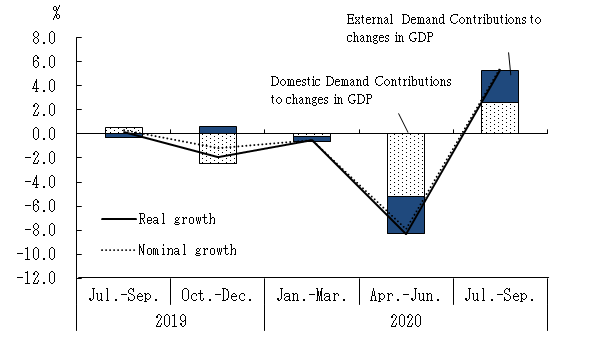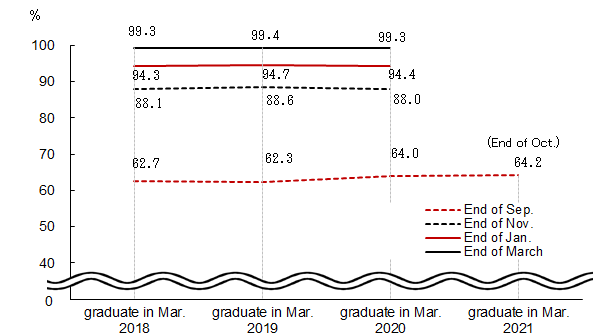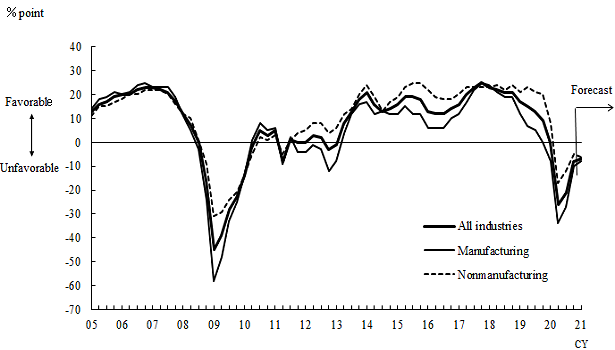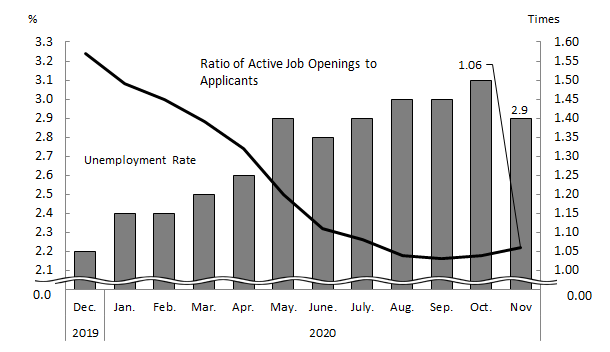Recent Statistical Survey Reports, December 2020
Statistical Survey Reports
Survey on Public Assistance Recipients (September)
December 2, released by the Ministry of Health, Labour and Welfare
The number of welfare recipients in September was 2,049,409 and the number of households of welfare recipients was 1,635,754.
Indexes of Business Conditions October 2020 (Preliminary Release)
December 7, released by the Cabinet Office
The Coincident Index of Composite Index (CI, revised figures, 2015=100) in October was 89.7, increased by 4.9 point. And 3 months backward moving average increased by 2.90 point, and 7 months backward moving average increased by 0.06 point. So the Assessment of Coincident Index was “Halting to fall”.
The Leading Index was 93.8, an increase of 0.5 point, and the Lagging Index was 89.9, a decrease of 1.8 point.
Family Income and Expenditure Survey (October)
December 8, released by the Ministry of Internal Affairs and Communications
The average monthly income for a worker’s households with 2 or more family members was up 2.5% in real terms from the previous year. The change over the year of wages & salaries was up 2.2% in real terms from the previous year (household heads: -0.5% in real terms, spouse of household: 13.2% in real terms).
The average of consumption expenditures for a worker’s household with 2 or more family members was up 2.8% in real terms from the previous year.
National Accounts (The 2ne Preliminary Estimates Jul.-Sep.2020)
December 8, released by the Cabinet Office![]()
Real GDP (Gross Domestic Product) growth rate (Seasonally Adjusted) at Jul.-Sep.2020 was 5.3% (22.9% on annual basis). Of real GDP growth rate, 2.6% was contributed by domestic demand and 2.7% by external demand.
Compensation of Employees (real) was 0.5% and compensation of Employees (nominal) was 0.6% (changes from the previous quarter (seasonally adjusted)).
Quartely Estimates of GDP: Jul. ~Sep. 2020 (The 2nd Preliminary Estimates)
Growth rate of GDP from the previous Quarters(seasonally adjusted)
Contributions of Domestic Demand and External Demand to Changes in GDP

Monthly Labour Survey (Provisional Report in October)
December 8, released by the Ministry of Health, Labour and Welfare![]()
Total amount of cash earnings decreased by 0.8% and contractual cash earnings decreased by 0.7% (full-time employees -1.1%, part-time employees 0.2%) from a year earlier.
Special cash earnings decreased by 7.2% from a year earlier. Scheduled cash earnings increased 0.3% and non-scheduled cash earnings decreased by 11.7% from year earlier. Real wage (total cash earnings) decreased by 0.2% from a year earlier and real wage (contractual cash earnings) decreased by 0.2% from a year earlier.
Non-scheduled hours worked decreased by 11.1% from a year earlier.
Non-scheduled hours worked by manufacturing industry workers increased by 3.8% from the previous month (seasonally adjusted).
Survey on Situation of Preliminary Job Offers for New Graduate (Senior and Junior High School) (End of October, 2020)
December 8, released by the Ministry of Health, Labour and Welfare
The ratio of final-year senior high school students with preliminary job offers was 64.2%, an increase of 0.2 point from the same period of the previous year.
The ratio of job openings to applicants for final-year senior high school students was 2.43, 0.32 point lower than the same period of the previous year.
The ratio of job openings to applicants for final-year junior high school students was 1.08, decreased 0.20 point from the same period of the previous year.
Trend in the percentage of final-year high school students
with official job offer

TANKAN (Short-Term Economic Survey of Enterprises) (December)
December 14, released by the Bank of Japan(PDF:595KB)![]()
The Diffusion Index (DI) (“Favorable”- “Unfavorable”) for business conditions in large enterprises of all industries was -8%point (-21 in the previous quarter and forecast -7 in the coming quarter), the manufacturing was -10%point and the non-manufacturing was -5%point.
The Diffusion Index (DI) (“Excessive”- “Insufficient”) for employment conditions in large enterprises of all industries was -4% point (-2 in the previous quarter and forecast -7 in the coming quarter), the manufacturing was 4%point and the non-manufacturing was -13%point.
Business Conditions
(Diffusion index of "Favorable" minus "Unfavorable," For Large Enterprise)

Survey on Labor Economic Trend (November 2020)
December 16, released by the Ministry of Health, Labour and Welfare
By the judgment of employment surplus or shortage DI as of November 1, 2020, regarding the trend of the sense of employment surplus or shortage, in the total of industries surveyed, regular staff, etc. accounted for 25 and the DI shows shortage for 38 consecutive terms. And, that of part-time workers accounted for 16 and the DI shows shortage for 45 consecutive terms.
Basic Survey on Labour Unions (2020)
December 16, released by the Ministry of Health, Labour and Welfare
The number of labour union members as of June 30, 2020 was 10.115 million, increased by 28 thousand (0.3%) from the previous year.
The estimated unionization rate was 17.1%, increased by 0.4 point from the previous year.
The number of labour union members of women was 3.435milliom, increased by 50 thousand (1.5%) from the previous year.
The number of labour union members of part-time workers was 1.375 million, increased by 42 thousand (3.1%) from the previous year.
Consumer Price Index Japan (November)
December 18, released by the Ministry of Internal Affairs and Communications
The consumer price index for Japan in November 2020 was 101.3(2015=100), down 0.9% from the previous year. All items, less fresh food, the comprehensive index was 101.2, down 0.9% from the previous year. All items, less fresh food and energy, the comprehensive index was 101.8, down 0.3% from the previous year.
Monthly Labour Survey (Final Report in September)
December 22, released by the Ministry of Health, Labour and Welfare![]()
Total amount of cash earnings decreased by 0.7% and contractual cash earnings decreased by 0.5% (full-time employees -1.1%, part-time employees 1.3%) from a year earlier.
Special cash earnings decreased by 9.0% from a year earlier. Scheduled cash earnings increased by 0.5% and non-scheduled cash earnings decreased by 12.0% from year earlier. Real wage (total cash earnings) decreased by 0.1% from a year earlier and real wage (contractual cash earnings) unchanged from the previous month.
Non-scheduled hours worked decreased by 11.1% from a year earlier.
Non-scheduled hours worked by manufacturing industry workers increased by 4.5% from the previous month (seasonally adjusted).
Indexes of Business Conditions October 2020(Revision of the Preliminary Release)
December 23, released by the Cabinet Office
The Coincident Index of Composite Index (CI, revised figures, 2015=100) in October was 89.4, an increase of 4.6 point. And 3 months backward moving average increased for 2.80 point, and 7 months backward moving average increased for 0.02 point. So the Assessment of Coincident Index was “Halting to fall”.
The Leading Index was 94.3, an increase of 1.0 point, and the Lagging Index was 91.2, a decrease of 0.5 point.
Consumer Price Index Ku-area of Tokyo (December (preliminary)
December 25, released by the Ministry of Internal Affairs and Communications
The consumer price index for Ku-area of Tokyo in December 2020(preliminary) was 100.9(2015=100), down 1.3% from the previous year. All items, less fresh food, the comprehensive index was 101.1, down 0.9% from the previous year. All items, less fresh food and energy, the comprehensive index was 101.9 down 0.4% from the previous year.
Labour Force Survey (November)
December 25, released by the Ministry of Internal Affairs and Communications
The unemployment rate (seasonally adjusted) was 2.9%, decreased by 0.2 point from the previous month. That for men was 3.2%, decreased by 0.2 point from the previous month and that for women was 2.4%, decreased by 0.3 point from the previous month.
The number of unemployed persons (seasonally adjusted) was 1.98 million, decreased by 160 thousand from the previous month.
The number of employees was 60.17 million, decreased by 290 thousand from the previous year.
Among them, the number of regular employee was 35.47 million, increased by 210 thousand from the previous year and the number of non-regular employee was 21.24 million, decreased by 620 thousand from the previous year.
Employment Referrals for General Workers (November)
December 25, released by the Ministry of Health, Labour and Welfare![]()
Active job openings-to-applicants ratio (seasonally adjusted) was 1.06, increased by 0.02 point from the previous month.
The number of monthly active job openings (person(s)) (seasonally adjusted) was increased by 3.0% from the previous month and the number of monthly active applications (person(s)) (seasonally adjusted) was increased by 1.5% from the previous month.
New job openings-to-applicants ratio (seasonally adjusted) was 2.02, increased by 0.20 point from the previous month.
Active job openings-to-applicants ratio for regular staff (seasonally adjusted) was 0.80, increased by 0.01 point from the previous month.
Trend in Unemployment Rate and Ratio of Active Job
Openings to Applicants (seasonally adjusted)

Survey on Supply and Demand of Construction Labor
December 25, released by the Ministry of Land, Infrastructure, Transport and Tourism
Indices of Industrial Production (November)
December 28, released by the Ministry of Economy, Trade and Industry![]()
The index of industrial production (seasonally adjusted, 2015=100) unchanged from the previous month. According to the Survey of Production Forecast in Manufacturing, Production is expected to decrease in December and increase in January.
Other Report
Monthly Economic Report (December)
December 22, released by the Cabinet Office![]()
The Japanese economy is still in a severe situation due to the Novel Coronavirus, but it is showing movements of picking up. (The same as the previous month.)
- Private consumption is picking up as a whole, while weakness can be seen in some sectors. (In the previous month, “Private consumption is picking up.”)
- Business investment is decreasing recently. (The same as the previous month.)
- Exports are increasing. (In the previous month, “Exports are picking up.”)
- Industrial production is picking up. (The same as the previous month.)
- Corporate profits are decreasing substantially due to the influence of the infectious disease, but the rate of decline is becoming smaller as a whole. Firms' judgments show movements of improvement, although some severe aspects remain. (In the previous month, “Corporate profits are decreasing substantially, as a whole due to the influence of the infectious disease, despite a smaller decline in some large companies. Firms' judgments show movements of improvement, although some severe aspects remain.”)
- Employment situation shows steady movements in some components such as the number of employees, while weakness remains, due to the influence of the infectious disease. (The same as the previous month.)
- Consumer prices are flat. (The same as the previous month.)
| To view PDF files, you will need Adobe Acrobat Reader Software installed on your computer.The Adobe Acrobat Reader can be downloaded from this banner. |

